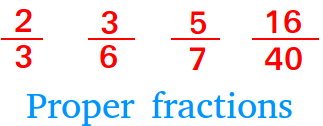Become math lovers!
What is a proper fraction ? Definition and examples.
A proper fraction is a common fraction that has a numerator that is smaller than the denominator.
The following fractions are examples of proper fractions.

Because the numerator is less than the denominator, the common fraction will always name a number that is less than 1.
For example, notice that 3/6 = 0.5 and 16/40 = 0.4
0.5 and 0.4 are smaller than 1.